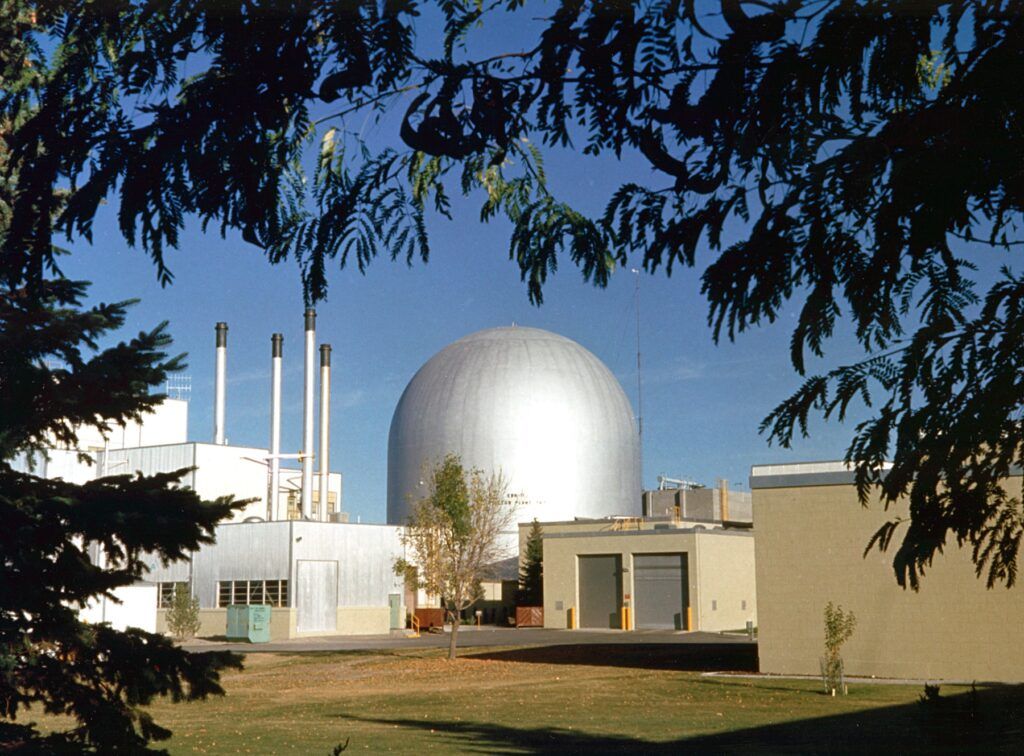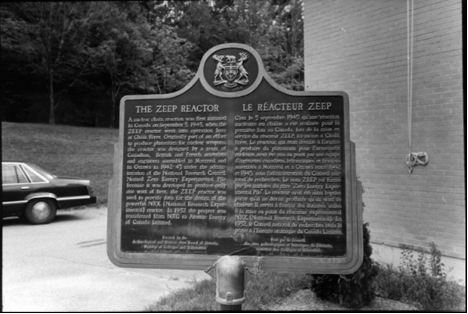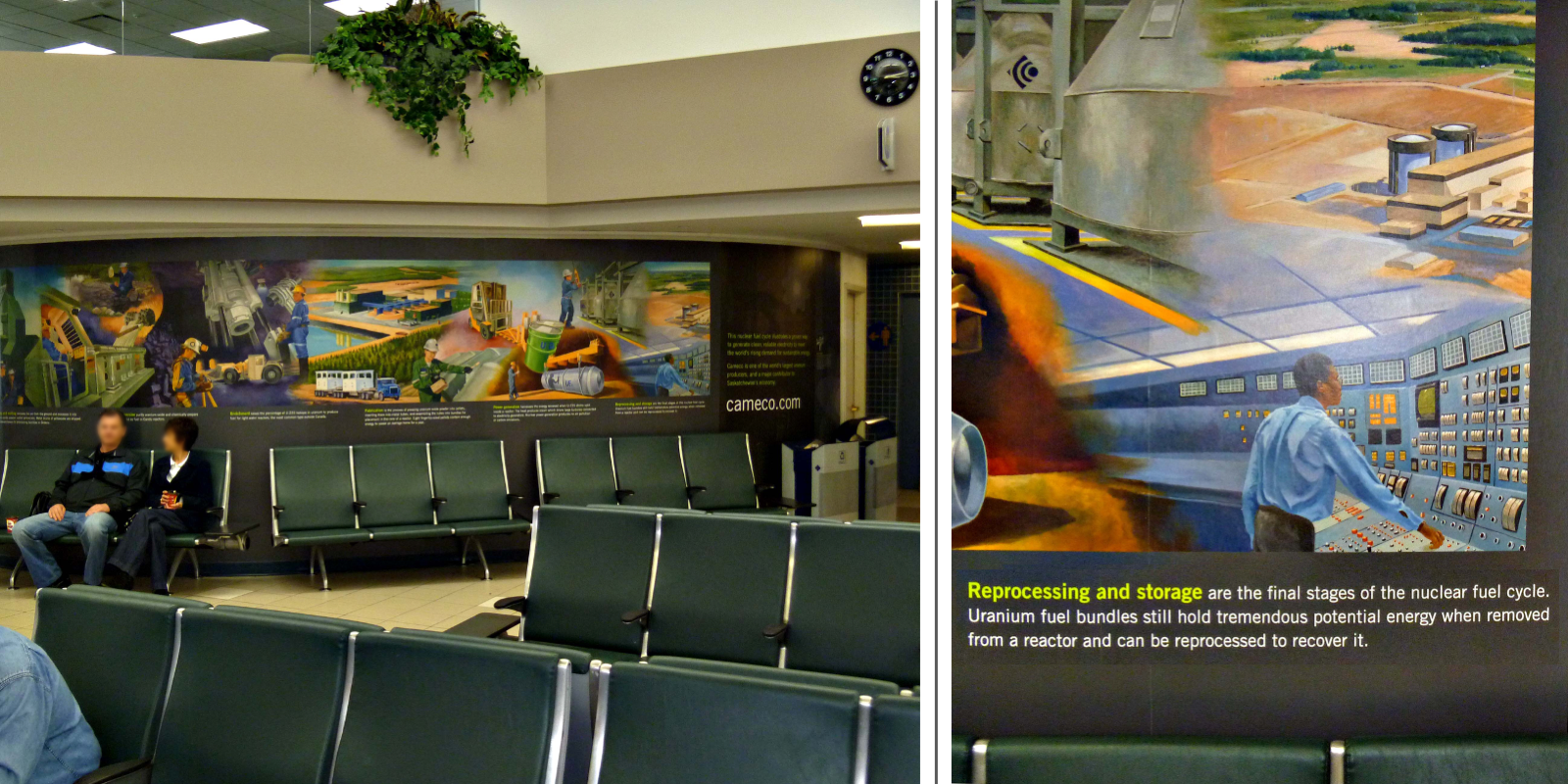Nuclear industry wants Canada to lift ban on reprocessing plutonium, despite proliferation risks
By Gordon Edwards, Susan O’Donnell | March 11, 2024
 Shut down in 1994, Idaho National Laboratory's Experimental Breeder Reactor II proved the concept of reactor fuel recycling. In Canada, two nuclear energy startups are proposing "advanced reactors" that would require used fuel to be recycled, likely through reprocessing—a technology banned for its proliferation risks. (Credit: Idaho National Laboratory, via Flickr)
Shut down in 1994, Idaho National Laboratory's Experimental Breeder Reactor II proved the concept of reactor fuel recycling. In Canada, two nuclear energy startups are proposing "advanced reactors" that would require used fuel to be recycled, likely through reprocessing—a technology banned for its proliferation risks. (Credit: Idaho National Laboratory, via Flickr)
Plutonium is “the stuff out of which atomic bombs are made.” Plutonium can also be used as a nuclear fuel. Reprocessing is any technology that extracts plutonium from used nuclear fuel. In Canada, the nuclear industry seems determined to close the nuclear fuel cycle by pushing for a policy to permit reprocessing—thereby seeking to lift a 45-year-old ban.
In 1977, Canada tacitly banned commercial reprocessing of used nuclear fuel, following the lead of the Carter administration, which explicitly opposed reprocessing because of the possibility it could lead to increased proliferation of nuclear weapons around the world.[1] That unwritten policy in Canada has held sway ever since.[2] New documents obtained through Canada’s Access to Information Act reveal that, behind closed doors, the nuclear industry has been crafting a policy framework that, if adopted, would overturn the ban and legitimize the extraction of plutonium from Canada’s used commercial nuclear fuel.
For over two years, documents show that the Canadian government has held a series of private meetings with industry representatives on this subject, keeping such activities secret from the public and from parliament. This raises questions about the extent to which nuclear promoters may be unduly influencing public policymaking on such sensitive nuclear issues as reprocessing in Canada.[3] But, given the stakes for the whole society and even the entire planet, the public must have a say about nuclear policy decisions.
Background to the ban. In the months preceding the 1977 ban, Atomic Energy of Canada Limited (AECL)—a corporation that is wholly owned by the Canadian government—was seeking approval to build two commercial reprocessing plants. “We are already late in starting,” warned AECL’s chairman Ross Campbell during a day-long seminar on the Canadian nuclear fuel cycle. “Admittedly, [it] takes a certain amount of guts,” said the company’s president John Foster, “because authorities all over the world are proceeding with understandable caution in the face of the bad name undeservedly attached to plutonium…. But plutonium is an extremely useful material, and we will be dealing in it.”
India’s 1974 atomic bomb test was still reverberating. The plutonium for this atomic bomb had come from a Canadian research reactor given to India for “peaceful purposes.” President Carter banned US commercial reprocessing in 1977, citing non-proliferation concerns, as plutonium for civilian use can be diverted to produce nuclear weapons. Canada’s Prime Minister Pierre Elliot Trudeau (the father of current incumbent Justin Trudeau) quietly followed suit. By then it was known that all reactor-produced plutonium is weapon-usable. In 1978, an Ontario Royal Commission report advised the government against reprocessing. The commission recommended on-site storage of used nuclear fuel (that is, near the generating station), because centralized storage would “presuppose the reprocessing of spent fuel.”[4] Commercial reprocessing became de facto banned in Canada and the AECL proposal was nixed.

Before the ban. Dreams of a plutonium-fueled economy were spawned in 1943-44 by British, French, and Canadian scientists working at a secret wartime laboratory in Montreal, which was part of the Anglo-American Project to build the first atomic bombs. Canada’s first heavy-water reactors were designed by the Montreal team, in part, to produce plutonium for weapons. The team also had hopes that after the war, plutonium might become a dream fuel for the future. They envisioned a “breeder reactor” that could produce more plutonium than it uses, thereby extending nuclear fuel supplies.
For 20 years after the war, Canada sold uranium and plutonium for US bombs. Two reprocessing plants were operated at Chalk River Nuclear Laboratories in Ontario. In addition, all the pilot work on plutonium separation needed to design Britain’s Windscale reprocessing plant was carried out at Chalk River.

After the ban. Although the 1977 ban scuppered AECL’s hopes for commercial reprocessing, plutonium remained the holy grail. In the decades that followed, AECL researchers studying the geologic disposal of high-level radioactive waste clandestinely carried out reprocessing experiments at the Whiteshell Nuclear Research Establishment in Manitoba. Instead of burying used nuclear fuel bundles, the scientists anticipated burying solidified post-reprocessing waste. Meanwhile, AECL scientists at Chalk River fabricated three tonnes of mixed-oxide fuel (MOX) in glove boxes, using plutonium obtained from CANDU fuel reprocessed overseas. In 1996, Prime Minister Jean Chrétien volunteered to import weapons-grade plutonium from dismantled US and Soviet warheads to fuel CANDU reactors. Facing fierce public opposition in Canada, the project never came to pass.
But the dream of a plutonium economy remained. In 2011, a sprawling mural on three walls of the Saskatoon Airport depicted the nuclear fuel chain, from mining uranium to the reprocessing of used fuel to recover “potential energy” before disposing of the leftovers. Although the word plutonium appeared nowhere, reprocessing was presented as the inevitable final step in this vision of a virtuous nuclear fuel cycle. The mural was commissioned by Cameco, the giant Canadian multi-national corporation that helped make the central Canadian province of Saskatchewan into the “Saudi Arabia of uranium.” At the time, Cameco co-owned the largest operating nuclear power station in the world, the eight-reactor Bruce complex beside Lake Huron bordering the United States.

Despite such hopes, it became fashionable to publicly downplay reprocessing as expensive and therefore economically unlikely.[5] But the technology stayed on the books as a possibility, especially in case future generations would want to extract plutonium from used nuclear fuel for re-use before disposing of the remaining radioactive waste.
Back to the future? New Brunswick has one 660-megawatt-electric CANDU reactor at Point Lepreau on the Bay of Fundy in eastern Canada. The plant has been operating for over 40 years. In March 2018, two start-up companies—UK-based Moltex Energy and US-based ARC Clean Technology—offered to build “advanced” (fast) reactors on the same site.
The Moltex design is a 300-megawatt-electric molten salt reactor called “Stable Salt Wasteburner.” It is to be fueled with plutonium and other transuranic elements extracted from CANDU used fuel already stored on that site. Accordingly, the Moltex proposal requires a reprocessing plant in tandem with the reactor. The ARC design is a 100-megawatt-electric liquid sodium-cooled reactor, inspired by the second Experimental Breeder Reactor (EBR-2) operated by the Argonne National Laboratory in Idaho between 1964 and 1994. Although the ARC-100 does not require reprocessing at the outset, its optimal performance requires that the used fuel be recycled, likely through reprocessing.
From the beginning, Moltex claimed its proposed molten salt reactor would “recycle” CANDU used fuel and “burn” it in its molten salt reactor. Moltex claims that this would virtually eliminate the need for a deep geologic repository by turning a million-year disposal problem into a roughly 300-year storage problem. This claim has been flatly rebuffed.[6] Only later did the public learn that the Moltex technology requires reprocessing CANDU used fuel to extract plutonium using an innovative process called “pyroprocessing.” (In pyroprocessing, used fuel is converted to a metal and immersed in molten salt, then the plutonium and other transuranic elements are recovered by passing a current through the salt and collecting the desired products on electrodes.)
ARC Clean Technology maintains that its reactor design is proven by the 30-year operating experience of the EBR-2 reactor, despite differences in size and fuel enrichment.[7] The company, however, says nothing about the intimate connection between breeder reactors and plutonium, nor does it mention the chequered history of liquid sodium-cooled reactors globally—including the Fermi Unit 1 reactor’s partial meltdown near Detroit, the commercial failure of France’s Superphénix, the conversion of a German breeder reactor into an amusement park, or the dismal performance of Japan’s Monju reactor.
For either of the proposed New Brunswick reactors to operate as intended, Canada would need to lift its 45-year-old ban on commercial reprocessing of used nuclear fuel.
Testing the limits. The first sign that Canada’s reprocessing ban might be lifted came in 2019, when the federal government’s Impact Assessment Act exempted specified projects from environmental assessment. The exemption included any reprocessing plant with a production capacity of up to 100 metric tons (of used nuclear fuel) annually—just above the reprocessing capacity required for the Moltex project.[8]
Public calls to explicitly ban reprocessing started shortly after March 2021, when the federal government gave 50.5 million Canadian dollars in funding for Moltex’s project. This project clearly requires reprocessing: Without the plutonium produced by CANDU reactors to fuel its proposed molten salt reactor, the Moltex project can go nowhere.
In addition, Moltex hopes to eventually export the technology or the fuel, or both. Many Canadians are alarmed at the prospect of normalizing the use of recycled plutonium as a nuclear fuel in Canada and abroad.
In 2021, in response to a recommendation by the International Atomic Energy Agency, the Canadian government conducted public consultations to develop a modernized policy on commercial radioactive waste management and decommissioning. Over 100 citizens groups participated, and many called for an explicit ban on reprocessing.
Public attention to the issue of reprocessing grew after nine US nonproliferation experts sent an open letter to Prime Minister Justin Trudeau in May 2021. The letter expressed concern that by funding a spent fuel reprocessing and plutonium extraction project, Canada would “undermine the global nuclear weapons nonproliferation regime that Canada has done so much to strengthen.” The experts pointed out that Canada’s support of the Moltex project could be used by other countries to justify their own reprocessing development or plutonium acquisition programs. Such a policy shift would undo decades of efforts to keep nuclear weapons-usable materials out of the hands of countries inclined to join the ranks of unofficial nuclear-weapons states. At the time, the authors urged the government of Canada to undertake an independent review of the proliferation implications of the project, particularly since it is intended for the export market.
A second letter sent to Trudeau in July 2021 refuted “misleading claims” that Moltex posted on-line in rebuttal to the first letter. Moltex’s rebuttal claims were quickly taken down. And a third letter authored by one of the US nonproliferation experts was sent in November 2021. None of the government responses to these three letters addressed the core issue, which is the request for an independent review of the proliferation implications of Canada’s funding of reprocessing.
The federal government released its draft policy for radioactive waste management and decommissioning in March 2022, hinting that reprocessing might be permitted in the future. Public interest groups made their opposition to that suggestion very clear. A national steering group coordinated by Nuclear Waste Watch, a Canada-based network of public interest organizations, released an alternative policy proposal that explicitly banned reprocessing. The Council of Canadians, a national advocacy group, sent out an action alert that generated 7,400 letters calling for the explicit prohibition of reprocessing.
In December 2022, non-governmental organizations launched a three-month pan-Canadian campaign, urging a ban on reprocessing in Canada. It engaged dozens of activist groups, produced webinars with high-profile experts on plutonium and nuclear proliferation, issued news releases and videos, and sent hundreds of letters to the prime minister, cabinet members and members of local parliaments. All pointed to the danger of undermining global nuclear non-proliferation efforts by encouraging commercial reprocessing.
Access to information. At the end of 2022, one of the authors made a request under Canada’s Access to Information Act to find out what discussions on reprocessing have taken place. Documents made available in August 2023 revealed that an industry-led initiative on developing a reprocessing policy has been entertained by government agencies since 2021.
The Canadian Nuclear Safety Commission, tasked with the job of licensing Moltex’s proposed reactor, declared that a policy framework for reprocessing is necessary and that such a policy must come from the federal government.[9] Moltex’s Chief Executive Officer, Rory O’Sullivan, observed that Canada was chosen by Moltex because the country had no explicit policy on reprocessing: “Moltex would likely not have come to Canada if a reprocessing policy had been mandated at the time.”
In November 2021, Canada’s Ministry of Natural Resources—the lead federal department on nuclear issues—issued an internal memo entitled “Policy Development on Reprocessing” that refers to a series of planned meetings on reprocessing with industry representatives starting December 1, 2021.[10] The CANDU Owners Group—a nonprofit corporation assembling utilities operating CANDU reactors, Canadian Nuclear Laboratories, and nuclear suppliers—was singled out by the ministry to prepare a policy paper on reprocessing.[11]
The CANDU Owners Group is far from neutral or independent.
First, Canadian Nuclear Laboratories is a private company owned by a consortium of multi-national companies: AtkinsRéalis (formerly SNC Lavalin), Fluor, and Jacobs. The company is currently constructing a government-funded facility with hot cells at Chalk River to conduct research, including on reprocessing and plutonium extraction. Canadian Nuclear Laboratories operates under a “government-owned contractor operated” agreement with Atomic Energy of Canada Limited, the same publicly owned corporation that pushed for commercial reprocessing in the late 1970s.
The CANDU Owners Group also has overseas members, including utilities from China, Pakistan, India, South Korea, Argentina, and Romania. The first three countries are nuclear weapons states that either possess reprocessing plants for military purposes (India and Pakistan) or reportedly divert plutonium extracted from commercial spent fuel for military purposes (China), while South Korea and Argentina have for decades flirted with the idea of reprocessing.
By all evidence, the government of Canada is currently enlisting private entities that favor reprocessing to assist in the development of an industry-friendly policy on reprocessing. And the government does this without involving the public, parliament, or outside experts—all of whom have expressed a keen interest—and repeatedly asked to participate—in plutonium policy discussions. In the process, misleading information about reprocessing is being forwarded to government officials with no other voices to correct the record.[12]
In the most recent move, a dozen US nonproliferation experts wrote again to Prime Minister Trudeau on September 22, 2023, after the release of documents obtained through an access to information request. In their letter, the experts reiterated their concerns that the Canadian government is funding a project that would lead to increase the availability—and therefore potential proliferation—of weapons-usable plutonium for civilian purposes in Canada and beyond.
Democratic deficit. Despite all these developments, there has been no public discussion or parliamentary deliberation about the implications of introducing civilian reprocessing into Canada’s nuclear fuel cycle. Absence of transparency and public debate means the democratic process is being ignored. Yet, the issue is of great public importance because of the taxpayer money invested, proliferation risks involved, and the long-term societal implications of the security measures needed to safeguard nuclear weapons usable materials.
This makes one wonder why it took a group of concerned citizens and an access to information request to find out that, behind closed doors, the nuclear industry has been drafting its own policy to permit commercial reprocessing, expecting its adoption by the government of Canada against all objective criteria of democracy.
In 1976, British nuclear physicist Brian Flowers authored a Royal Commission report to the UK parliament. He wrote: “We regard the future implications of a plutonium economy as so serious that we should not wish to become committed to this course unless it is clear that the issues have been fully appreciated and weighed; in view of their nature we believe this can be assured only in the light of wide public understanding.”
The same precept should apply to nuclear policy in today’s Canada.
Notes
[1] “Canada’s policy on reprocessing at some point changed to accord with the US policy declared by President Carter in 1977 although it appears no similar high level announcement was made by the Canadian government,” p. 24, Nuclear Waste Management Organization, Status of Nuclear Fuel Reprocessing, Partitioning and Transmutation, November 2003.
[2] “Canadian Policy regarding non-proliferation assumes no enrichment or reprocessing in Canada,” CNSC Briefing Paper, 2014. in ATIP-CNSC. “Whether Canada decides on reprocessing nuclear fuel is a policy decision [and] not the role of the CNSC.” Internal email from CNSC President, July 28, 2021, in ATIP-CNSC.
[3] “While the industry has been able to progress discussions and appreciates the support we have received from the various key federal departments/agencies, the industry believes that it will need an increased level of engagement by those organizations to resolve these matters into a policy position at a pace that will support nuclear industry planning needs to support the low-carbon transition.” Strategy to establish a Policy on Used Nuclear Fuel Reprocessing, September 21, 2022, Natural Resources Canada (internal document), ATIP-NRCAN.
[4] “Clearly the case for a central interim storage facility is fundamentally predicated on whether or not it is decided to reprocess CANDU spent fuel and to recycle the plutonium…. From health, environmental and safety points of view, we believe that the existing CANDU fuel cycle is much preferable to an advanced fuel cycle which would necessitate reprocessing.” 1978, A Race Against Time: An Interim Report on Nuclear Energy in Ontario, p.91, Royal Commission on Electric Power Planning, Queen’s Park. Toronto.
[5] “Until now, the nuclear industry has viewed the reprocessing and recycling of spent fuel as not cost effective or necessary at an industrial scale, given Canada’s large high-grade uranium deposits, the low price of uranium, and the high cost of reprocessing and recycling spent fuel.” Memorandum to the Deputy Minister of Natural Resources, undated, ATIP-NRCAN.
[6] “Moltex’s claims of removing plutonium and other long-lived transuranic elements from CANDU spent fuel to reduce long-term risk from a deep underground radioactive waste repository have been discredited,” Briefing Note to President Velshi, Annex H, Thursday, June 16, 2022, in ATIP-CNSC. “The need for a repository is never eliminated with reprocessing or transmutation.” Briefing on Processing and Reprocessing Facilities for President Velshi, November 25, 2014, in ATIP-CNSC.
[7] The EBR-2 reactor was 20 megawatt-electric using 67-percent enriched uranium fuel; the ARC reactor is 100 megawatt-electric using 10.9-percent to 15.5-percent enriched uranium fuel.
[8] The Moltex reactor will require about 392 kilograms of plutonium per year as fuel, based on data provided in recorded testimony by Moltex CEO Rory O’Sullivan in 2023. Coincidentally, a reprocessing facility that handles 100 metric tons of CANDU used fuel annually will yield about 420 kilograms of plutonium every year. It seems to be an almost perfect fit between government regulations and industry requirements.
[9] “The Government should address outstanding policy issues – e.g. reprocessing, project vetoes – to ensure clarity is provided prior to a project entering the regulatory process.” Canadian Nuclear Safety Commission, Points to raise with the Minister, email, October 20, 2022, ATIP-CNSC. “For the regulatory process to be predictable and efficient – policy issues need to be resolved in advance. One example is reprocessing; Difficult to regulate in a policy void – or perceived policy void.” Canadian Nuclear Safety Commission, speaking points for Public Policy Forum, October 24, 2022, ATIP-CNSC.
[10] A series of government e-mails with the subject line “Discussion topics related to recycling/ reprocessing paper,” from November 2021 to November 2022, include the following from an official with Natural Resources Canada: “Here’s what we had shared with the COG task group in terms of Qs on waste when we kick-started the reprocessing ‘policy’ topical sessions back in December 2021. I’ll re-iterate tomorrow that as a first step to help us pull together a briefing package on reprocessing, for industry to provide us answers to the questions.” Nov 2021-Nov 2022, ATIP-NRCAN.
[11] “The nuclear industry established an SMR recycling/reprocessing task team under the Candu Owners Group. Following numerous discussions with senior representatives in NRCan, Global Affairs Canada, and the CNSC departments of security, safeguards, import and export, high level principles were developed that the task team believes provides guidance on the key areas of interest. These principles could form the basis of a national policy…. The aspirational goal is to have a policy issued by spring 2023.” Candu Owners Group, “Strategy to Establish a Policy on Used Nuclear Fuel Reprocessing,” Natural Resources Canada (internal document), September 21, 2022, ATIP-NRCAN.
[12] In an undated 5-page Memorandum to the Deputy Minister of Natural Resources, labelled “for information,” the Deputy Director of Nuclear Science and Technology writes: “It should be noted that reprocessing is currently being carried out internationally by several nations using processes similar to the Moltex WATSS process, but which more completely separate plutonium from the other materials and contaminants in the fuel, and do so successfully while following international safeguards protocols, and under the purview of the IAEA.” This statement is false. ATIP-NRCAN.
Together, we make the world safer.
The Bulletin elevates expert voices above the noise. But as an independent nonprofit organization, our operations depend on the support of readers like you. Help us continue to deliver quality journalism that holds leaders accountable. Your support of our work at any level is important. In return, we promise our coverage will be understandable, influential, vigilant, solution-oriented, and fair-minded. Together we can make a difference.
















Hope they lift the ban! Nuclear is the future. No point in being scared of something that won’t happen. You really think that Canada isn’t going to heavily guard this? I don’t think you understand how HEAVILY guarded this stuff is. Also you can make a bomb out of Uranium too and no one is crying about that.